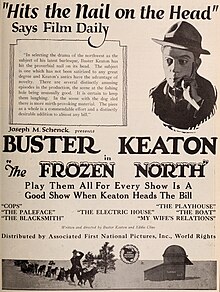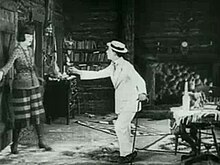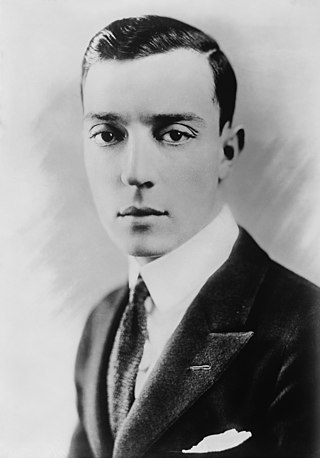
Joseph Frank "Buster" Keaton was an American actor, comedian and director. He is best known for his silent film work, in which his trademark was physical comedy accompanied by a stoic, deadpan expression that earned him the nickname "The Great Stone Face".

Sherlock Jr. is a 1924 American silent comedy film directed by and starring Buster Keaton and written by Clyde Bruckman, Jean Havez, and Joseph A. Mitchell. It features Kathryn McGuire, Joe Keaton, and Ward Crane.

Roscoe Conkling "Fatty" Arbuckle was an American silent film actor, director, and screenwriter. He started at the Selig Polyscope Company and eventually moved to Keystone Studios, where he worked with Mabel Normand and Harold Lloyd as well as with his nephew, Al St. John. He also mentored Charlie Chaplin, Monty Banks and Bob Hope, and brought vaudeville star Buster Keaton into the movie business. Arbuckle was one of the most popular silent stars of the 1910s and one of the highest-paid actors in Hollywood, signing a contract in 1920 with Paramount Pictures for $1,000,000 a year.

Edward Francis Cline was an American screenwriter, actor, writer and director best known for his work with comedians W.C. Fields and Buster Keaton. He was born in Kenosha, Wisconsin and died in Hollywood, California.

William Surrey Hart was an American silent film actor, screenwriter, director and producer. He is remembered as a foremost Western star of the silent era who "imbued all of his characters with honor and integrity." During the late 1910s and early 1920s, he was one of the most consistently popular movie stars, frequently ranking high among male actors in popularity contests held by movie fan magazines.

One Week is a 1920 American two-reel silent comedy film starring Buster Keaton, the first independent film production he released on his own. The film was written and directed by Keaton and Edward F. Cline, and runs for 19 minutes. Sybil Seely co-stars. The film contains a large number of innovative visual gags largely pertaining to either the house or to ladders.

Convict 13 is a 1920 two-reel silent comedy film starring Buster Keaton. It was written and directed by Keaton and Edward F. Cline.

Neighbors is a 1920 two-reel silent comedy film co-written, co-directed by, and starring Buster Keaton.
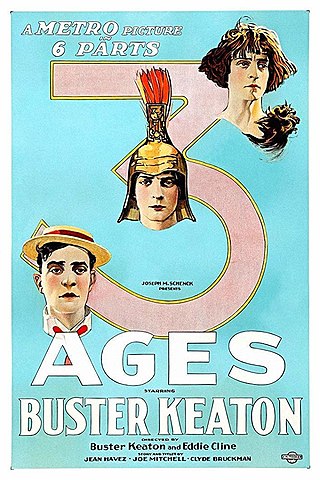
Three Ages is a 1923 black-and-white American feature-length silent comedy film starring comedian Buster Keaton and Wallace Beery. The first feature Keaton wrote, directed, produced, and starred in, Keaton structured the film like three inter-cut short films. While Keaton was a proven success in the short film medium, he had yet to prove himself as a feature-length star. It has been alleged that, had the project flopped, the film would have been broken into three short films, although this has been disputed by film historians who note that neither Keaton nor his associates made this claim in their lifetimes. The structure also worked as a parody of D. W. Griffith's 1916 film Intolerance.
Seven Chances is a 1925 American silent comedy film directed by and starring Buster Keaton, based on the play of the same name by Roi Cooper Megrue, produced in 1916 by David Belasco. Additional cast members include T. Roy Barnes, Snitz Edwards, and Ruth Dwyer. Jean Arthur, a future star, has an uncredited supporting role. The film's opening scenes were shot in early Technicolor.
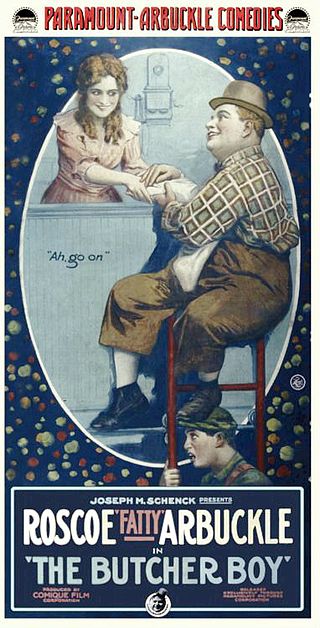
The Butcher Boy is a 1917 American two-reel silent comedy film written by, directed by, and starring Roscoe "Fatty" Arbuckle and featuring Al St. John, Buster Keaton and Alice Lake. This was the first in Arbuckle's series of films with the Comique Film Corporation, and Keaton's film debut.

Out West is a 1918 American two-reel silent comedy film, a satire on contemporary Westerns, starring Roscoe 'Fatty' Arbuckle, Buster Keaton, and Al St. John. It was the first of Arbuckle's "Comique" films to be filmed on the West Coast, the previous five having been filmed in and around New York City. The idea for the story came from Natalie Talmadge, who was later to become Keaton's first wife.

The High Sign is a 1921 two-reel silent comedy film starring Buster Keaton, and written and directed by Keaton and Edward F. Cline. Its runtime is 21 minutes. Although One Week (1920) was Keaton's first independent film short released, The High Sign was the first one made. Disappointed with the result, Keaton shelved it and the film was not released until the following year. The title refers to the secret hand signal used by the film's underworld gang.

Good Night, Nurse! is a 1918 American two-reel silent comedy film written by, and directed by, and starring Roscoe "Fatty" Arbuckle and featuring Buster Keaton. The action centers in a sanitarium where Arbuckle's character is involuntarily brought to by his wife to be operated on by Keaton's character for alcoholism.

Back Stage is a 1919 American two-reel silent comedy film directed by and starring Roscoe "Fatty" Arbuckle and featuring Buster Keaton and Al St. John.

Coney Island is a 1917 American two-reel silent comedy film starring, written and directed by Roscoe "Fatty" Arbuckle and featuring Buster Keaton.

Oh Doctor! is a 1917 American two-reel silent comedy film directed by and starring Roscoe "Fatty" Arbuckle and featuring Buster Keaton.

Moonshine is a 1918 American two-reel silent comedy film directed by and starring Roscoe "Fatty" Arbuckle and featuring Buster Keaton. The movie is available on Youtube.

Elgin Lessley was an American hand-crank cameraman of the silent film era—a period of filmmaking when virtually all special effects work had to be produced inside the camera during filming. Though Lessley worked earlier with Roscoe "Fatty" Arbuckle, and later with Harry Langdon, he is best known for the groundbreaking effects he produced with Buster Keaton, who dubbed him "the human metronome" for his ability to crank consistently at any requested speed.

Luke the Dog (1913–1926) was an Staffordshire Bull Terrier that performed as a recurring character in American silent comedy shorts between 1914 and 1920. He was also the personal pet of actress Minta Durfee and her husband, the comedian and director Roscoe "Fatty" Arbuckle.
